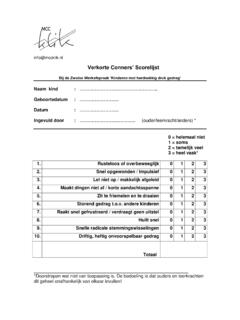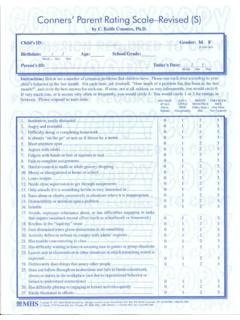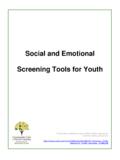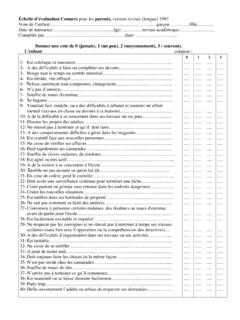Transcription of Children of Mothers with Serious Substance Abuse …
1 THE AMERICAN JOURNAL OF DRUG AND ALCOHOL ABUSEVol. 29, No. 4, pp. 743 758, 2003 Children of Mothers with Serious SubstanceAbuse Problems: An Accumulation of Risks#Nicola A. Conners, ,1,*Robert H. Bradley, ,2 Leanne Whiteside Mansell, ,1 Jeffrey Y. Liu, ,3 Tracy J. Roberts, ,3 Ken Burgdorf, ,3and James M. Herrell, , for Inclusive Communities, University of Arkansasfor Medical Sciences, North Little Rock, Arkansas, USA2 Center for Applied Studies in Education, University at Little Rock,Little Rock, Arkansas, USA3 Caliber Associates, Inc., Fairfax, Virginia, USA4 Center for Substance Abuse Treatment, Substance Abuse and MentalHealth Services Administration, Department of Healthand Human Services, Rockville, Maryland, USA#Views and opinions are those of the authors and do not necessarily reflect those ofCSAT, SAMHSA, or DHHS.
2 *Correspondence: Nicola A. Conners, , Pediatrics/Partners for Inclusive Com-munities, University of Arkansas for Medical Sciences, 2001 Pershing Circle, Suite 300,North Little Rock, AR 72114, USA; Fax: (501) 682-9991; E-mail: (Print); 1097-9891 (Online)CopyrightD2003 by Marcel Dekker, study examines the life circumstances and experiences of 4084children affected by maternal addiction to alcohol or other drugs. Thepaper will address the characteristics of their caregivers, the multiple riskfactors faced by these Children , their health and development, and theirschool performance. Data were collected from Mothers at intake into 50publicly funded residential Substance Abuse treatment programs forpregnant and parenting women.
3 Findings from this study suggest thatchildren whose Mothers Abuse alcohol or other drugs confront a highlevel of risk and are at increased vulnerability for physical, academic,and socioemotional problems. Children affected by maternal addictionare in need of long-term supportive Words: Substance Abuse ; Children ; Risk factors; there are few reliable estimates of the numbers of childrenin the United States whose Mothers are addicted to alcohol or other drugs,the information available suggests the number may be shockingly estimate that up to 15% of all American women between 15and 44 years old Abuse alcohol or illicit drugs (1). Results from thecombined 2000 and 2001 National Household Survey on Drug Abuse (NHSDA) indicate of pregnant women reported using illicit drugs inthe prior month (2).
4 Also based on the NHSDA, it has been estimated that10% of Children (more than 7 million) have at least one parent who isdependent on alcohol or illicit drugs and that 6% have at least one parentwho is in need of treatment for illicit drug use (3). These estimates suggestthat millions of Children currently are being reared in environmentscharacterized by maternal of Substance abusing parents are widely considered at highrisk for a range of biological, developmental, and behavioral problems,including for developing Substance Abuse problems of their own. However,while much has been written about possible risks that parental substanceabuse poses to Children , there is almost no systematic documentation of thelife circumstances of these Children .
5 Further documentation of the lifeexperiences of such Children is critically needed for both policy makers andthose involved in planning health and human services. Although studiesexamining the effects of prenatal exposure to drugs and alcohol on thehealth and early developmental course of Children are making clearer thebiologic vulnerability of Children born to addicted Mothers , comparativelylittle attention has been given to the postnatal environmental factors thatmay negatively impact Children s development. The broader literature onrisk exposure suggests that the accumulation of postnatal environmental risk744 Conners et may combine with prenatal exposure to alcohol or other drugs(AOD) in both an additive and an interactive fashion, dramatically in-creasing total vulnerability to developmental limited research on families affected by parental addiction consistsmostly of case studies or studies involving very small samples.
6 Thus, thereis reason to be concerned about generalizability. Moreover, studies ofchemically dependent families have focused most commonly on intactfamilies with an alcoholic father (4). To what extent the impact of paternalalcoholism on Children may be similar to that of maternal Substance ad-diction is purpose of this study is to offer some insight into the lifecircumstances and experiences of a large group of Children affected bymaternal addiction, Children whose Mothers addiction is severe enough towarrant their admission to long-term residential facilities for pregnant andparenting women and their Children . This paper will address the followingquestions about this group of Children : 1) Who is acting as the primarycaregiver for these Children ?
7 What strengths and/or challenges do thesecaregivers have that would affect their ability to provide for the physicaland emotional needs of the Children in their care? 2) What percentage ofchildren operate under multiple risk factors known to lead to poor out-comes? 3) What physical or developmental problems do these childrenexperience? 4) How do these Children perform in school?METHODP rocedureOur study relies on data collected on women and Children served by theResidential Women and Children (RWC)/Pregnant and Postpartum Women(PPW) programs. The Substance Abuse and Mental Health ServicesAdministration/Center for Substance Abuse Treatment (CSAT) funded theprojects from 1993 to 2000.
8 Each RWC/PPW project developed residentialsubstance Abuse treatment programs for women, including pregnant andpostpartum women and their infants and Children , and participated in anational cross-site national evaluation collected data from 50 (26 RWC and 24 PPW) projects from 1996 to 2000. These programs were diverse in manyways. Some targeted clients from specific racial or ethnic groups, whileothers served diverse clienteles. The RWC/PPW projects were locatedacross all regions of the country, with the largest numbers of programs inthe Northeast. While most programs were located in urban areas, othersChildren of Substance Abusing Mothers745were located in suburban neighborhoods or rural areas, with a few onIndian RWC/PPW project collected and submitted a standard set ofclient- and child-level data on a quarterly basis.
9 Programs used softwareprovided by CSAT s cross-site contractor to transmit data to a centrallocation for processing and analysis. All programs involved in the cross-sitestudy were required to send staff to a conference where they were trained inthe procedures of the study and in the administration of the data collectioninstruments. Due to possible staff turnover, further training also was offeredat later grantee conferences and during site paper uses data collected from families at intake into data collection instruments were developed by CSAT staff and theircross-site contractor, with extensive input from experts in the field. Theteam reviewed relevant literature from the field of Substance Abuse treat-ment and prevention, as well as existing data collection tools, and de-veloped two intake instruments: one for women entering treatment and onefor their Children .
10 Both intake instruments were designed to be administeredto the mother by a trained staff member (usually the counselor or intakecoordinator) during the first week after treatment intake instrument for women entering treatment was designed tocollect information about individual, familial, and social factors believed toaffect women s retention in Substance Abuse treatment and the probabilityof successful completion of treatment. Parts of the instrument were modeledafter the Addiction Severity Index (ASI), a widely used semi-structuredinterview, which is designed to gather information about aspects of aclient s life that may contribute to their Substance Abuse problem (5).





